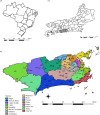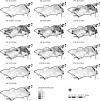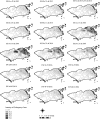Spatial diffusion of the 2015-2016 Zika, dengue and chikungunya epidemics in Rio de Janeiro Municipality, Brazil
- PMID: 31364556
- PMCID: PMC6625212
- DOI: 10.1017/S0950268819001250
Spatial diffusion of the 2015-2016 Zika, dengue and chikungunya epidemics in Rio de Janeiro Municipality, Brazil
Abstract
Different countries, especially Brazil, that have faced recurrent dengue epidemics for decades and chikungunya epidemics since 2014, have had to restructure their health services to combat a triple epidemic of arboviruses - Zika, dengue and Chikungunya - transmitted by the same vector, mainly Aedes aegypti, in 2015-2016. Several efforts have been made to better understand these three arboviruses. Spatial analysis plays an important role in the knowledge of disease dynamics. The knowledge of the patterns of spatial diffusion of these three arboviruses during an epidemic can contribute to the planning of surveillance actions and control of these diseases. This study aimed to identify the spatial diffusion processes of these viruses in the context of the triple epidemic in 2015-2016 in Rio de Janeiro, Brazil. Two study designs were used: cross-sectional and ecological. Sequential Kernel maps, nearest-neighbour ratios calculated cumulatively over time, Moran global autocorrelation correlograms, and local autocorrelation changes over time were used to identify spatial diffusion patterns. The results suggested an expansion diffusion pattern for the three arboviruses during 2015-2016 in Rio de Janeiro. These findings can be considered for more effective control measures and for new studies on the dynamics of these three arboviruses.
Keywords: Chikungunya virus; Zika virus; dengue virus; spatio temporal analysis.
Conflict of interest statement
None.
Figures









Similar articles
-
Spatial diffusion of Zika fever epidemics in the Municipality of Salvador-Bahia, Brazil, in 2015-2016: does Zika fever have the same spread pattern as Dengue and Chikungunya fever epidemics?Rev Soc Bras Med Trop. 2020 Apr 3;53:e20190563. doi: 10.1590/0037-8682-0563-2019. eCollection 2020. Rev Soc Bras Med Trop. 2020. PMID: 32267460 Free PMC article.
-
The triple epidemics of arboviruses in Feira de Santana, Brazilian Northeast: Epidemiological characteristics and diffusion patterns.Epidemics. 2022 Mar;38:100541. doi: 10.1016/j.epidem.2022.100541. Epub 2022 Feb 1. Epidemics. 2022. PMID: 35123281
-
Spatial analysis of the incidence of Dengue, Zika and Chikungunya and socioeconomic determinants in the city of Rio de Janeiro, Brazil.Epidemiol Infect. 2021 Aug 2;149:e188. doi: 10.1017/S0950268821001801. Epidemiol Infect. 2021. PMID: 34338179 Free PMC article.
-
Human Urban Arboviruses Can Infect Wild Animals and Jump to Sylvatic Maintenance Cycles in South America.Front Cell Infect Microbiol. 2019 Jul 17;9:259. doi: 10.3389/fcimb.2019.00259. eCollection 2019. Front Cell Infect Microbiol. 2019. PMID: 31380302 Free PMC article. Review.
-
The Challenges Imposed by Dengue, Zika, and Chikungunya to Brazil.Front Immunol. 2018 Aug 28;9:1964. doi: 10.3389/fimmu.2018.01964. eCollection 2018. Front Immunol. 2018. PMID: 30210503 Free PMC article. Review.
Cited by
-
A Model for Highly Fluctuating Spatio-Temporal Infection Data, with Applications to the COVID Epidemic.Int J Environ Res Public Health. 2022 May 30;19(11):6669. doi: 10.3390/ijerph19116669. Int J Environ Res Public Health. 2022. PMID: 35682250 Free PMC article.
-
Spatiotemporal dynamics, risk areas and social determinants of dengue in Northeastern Brazil, 2014-2017: an ecological study.Infect Dis Poverty. 2020 Nov 3;9(1):153. doi: 10.1186/s40249-020-00772-6. Infect Dis Poverty. 2020. PMID: 33143752 Free PMC article.
-
Complex network analysis of arboviruses in the same geographic domain: Differences and similarities.Chaos Solitons Fractals. 2023 Mar;168:None. doi: 10.1016/j.chaos.2023.113134. Chaos Solitons Fractals. 2023. PMID: 36876054 Free PMC article.
-
The socio-spatial determinants of COVID-19 diffusion: the impact of globalisation, settlement characteristics and population.Global Health. 2021 May 20;17(1):56. doi: 10.1186/s12992-021-00707-2. Global Health. 2021. PMID: 34016145 Free PMC article.
-
High-risk spatial clusters for Zika, dengue, and chikungunya in Rio de Janeiro, Brazil.Rev Saude Publica. 2023 Jun 5;57:32. doi: 10.11606/s1518-8787.2023057004932. eCollection 2023. Rev Saude Publica. 2023. PMID: 37283400 Free PMC article.
References
-
- Ioos S et al. (2014) Current Zika virus epidemiology and recent epidemics. Médecine Et Maladies Infectieuses 44, 302–307. - PubMed
Publication types
MeSH terms
LinkOut - more resources
Full Text Sources
Medical

